-
Countries
-
Data and Analysis
-
Special Focus
-
Crisis Responses
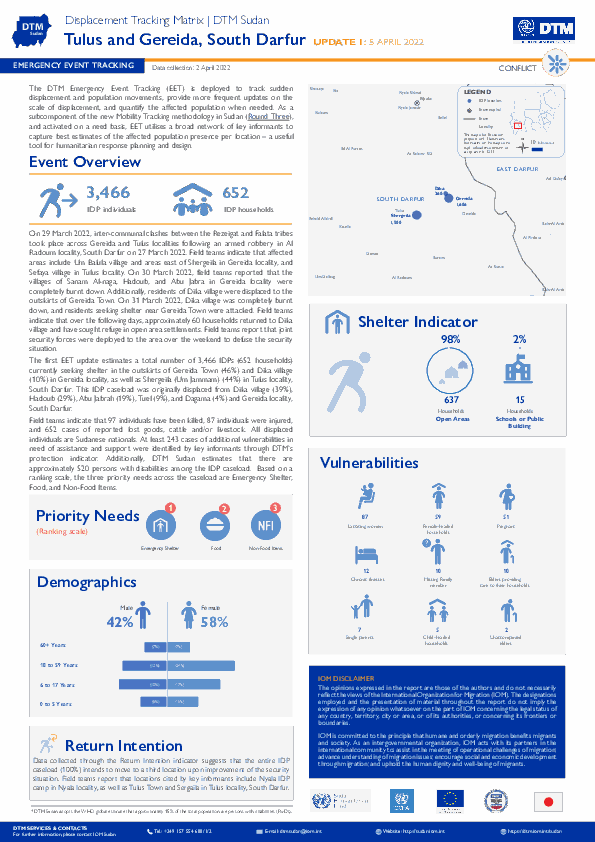
Contact
DTM Sudan; dtmsudan@iom.int
Language
English
Location
Sudan
Snapshot Date
Apr 02 2022
Activity
- Event Tracking
- Mobility Tracking
The DTM Emergency Event Tracking (EET) is deployed to track sudden displacement and population movements, provide more frequent updates on the scale of displacement, and quantify the affected population when needed. As a subcomponent of the new Mobility Tracking methodology in Sudan (Round Three), and activated on a needs basis, EET utilises a broad network of key informants to capture best estimates of the affected population presence per location – a useful tool for humanitarian response planning and design.

Contact
DTMUkraine@iom.int
Language
English
Location
Ukraine
Period Covered
Mar 24 2022
Apr 01 2022
Activity
- Survey
Since 24 February 2022 the war in Ukraine triggered an unprecedented humanitarian crisis across all of the country’s sub regional divisions oblasts. Between March 24 and April1, the International Organization for Migration conducted the second round of a rapid representative assessment of the general population in Ukraine to gather insights into internal displacement and mobility flows, and to assess local needs. This general population survey serves as a preliminary source to identify areas with high humanitarian needs and to inform the targeting of response aiming to assist the war affected population. The geographical scope of the assessment covers the entire territory of Ukraine, all five macro regions ( East, North, Centre, South, and the city of Kyiv), with the exception of the Crimean peninsula. The general population survey was constructed through a random digit dial (RDD) approach, and 2,000 unique and anonymous respondents aged 18 and over were interviewed using the computer assisted telephone interview (CATI) method. The estimates rely on the UNFPA population data for Ukraine, agreed upon as the common population baseline by the humanitarian community Those currently outside Ukraine were not interviewed. For further notes on method and limitations, including IOM’s definition of internally displaced persons used for the purpose of this assessment, see page 8.
This report is available in Ukrainian

Contact
REMAPBD@iom.int
Language
English
Location
Bangladesh
Period Covered
Mar 10 2020
Feb 28 2022
Activity
- Points of Entry (PoE)
The outbreak of the COVID-19 pandemic at the beginning of 2020 has affected global and regional mobility, including mobility in Bangladesh, through various travel disruptions and restrictions. To better understand how the pandemic affects global mobility, the International Organization for Migration (IOM) developed an online tool and database to register points of entry, exit and transit - such as airports and land and blue border crossing points - where mobility restrictions and preparedness and response measures are in place. To support these efforts, over a period of 24 months, the Displacement Tracking Matrix Regional Evidence for Migration Analysis and Policy (DTM REMAP) team in Bangladesh mapped and gathered data on the locations, statuses and restrictions at Points of Entry (PoE) in the country. The information gathered allows more in-depth analysis to uncover specific trends related to the locations, statuses and restrictions of PoEs in Bangladesh.
In February 2022, the DTM REMAP team in Bangladesh assessed 23 PoEs. The most common type of PoE reported was land borders (12), followed by airports (8) and blue borders (3). Internal transit points are not taken into account for analysis in this snapshot. During the PoE reporting period, the number of assessed PoEs in Bangladesh increased from 19 to 231 PoEs. The status of the PoEs changed notably. None of the PoEs were fully operational at the beginning of the assessment. However, by February 2022, 11 PoEs were fully operational, nine were partially operational, three were fully closed.
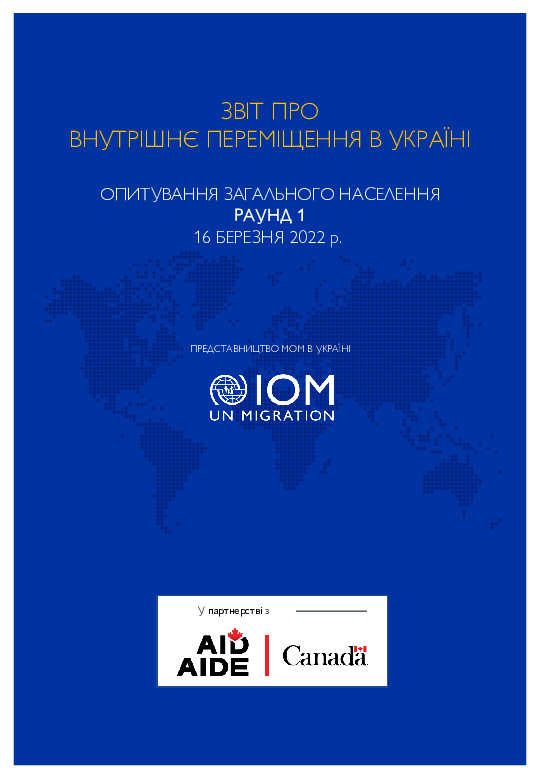
Contact
DTMUkraine@iom.int
Language
Ukrainian
Location
Ukraine
Period Covered
Mar 09 2022
Mar 16 2022
Activity
- Survey
24 лютого 2022 року в Україні розпочався широкомасштабний збройний конфлікт, який спричинив безпрецедентну гуманітарну кризу, що охопила всі області країни. У період з 9 по 16 березня Міжнародною організацією з міграції (МОМ) було проведено швидке репрезентативне оцінювання загального населення України для збору початкової інформації стосовно внутрішнього переміщення та його потоків, а також для оцінки місцевих потреб. Допоки триває запровадження Матриці відстеження переміщень, це оцінювання загального населення слугуватиме як первинне джерело для виявлення сфер із високими гуманітарними потребами та визначення цільових заходів реагування для надання допомоги населенню, що постраждало від конфлікту. Географічне охоплення цього оцінювання покриває всю територію України, всі п’ять макрорегіонів (захід, схід, північ, центр, південь та місто Київ), за винятком Кримського півострова. Імовірнісна вибірка, що забезпечує репрезентативність на рівні макрорегіону, була сформована шляхом набору випадкових телефонних номерів, завдяки чому було опитано 2 000 респондентів віком понад 18 років із використанням методу автоматизованого телефонного опитування (CATI). Особи, які наразі перебувають за межами України, під опитування не потрапили. Розрахунки населення включають припущення про те, що діти подорожують разом зі своїми дорослими опікунами. Оцінка спирається на дані про населення України ЮНФПА, які гуманітарна спільнота розглядає як базове значення для чисельності населення.
Цей звіт також доступний англійською мовою.
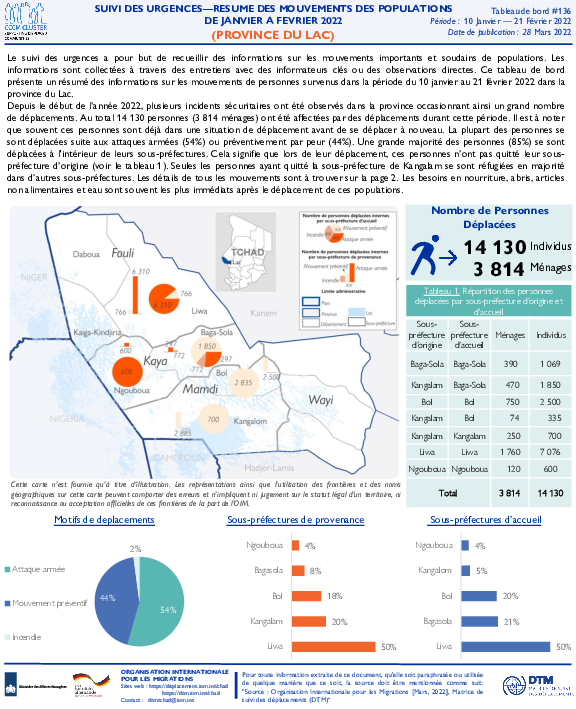
Contact
DTM Tchad, dtmtchad@iom.int
Language
French
Location
Chad
Period Covered
Jan 10 2022
Feb 21 2022
Activity
- Event Tracking
- Mobility Tracking
Le suivi des urgences a pour but de recueillir des informations sur les mouvements importants et soudains de populations. Les informations sont collectées à travers des entretiens avec des informateurs clés ou des observations directes. Ce tableau de bord présente un résumé des informations sur les mouvements de personnes survenus dans la période du 10 janvier au 21 février 2022 dans la province du Lac.
Depuis le début de l’année 2022, plusieurs incidents sécuritaires ont été observés dans la province occasionnant ainsi un grand nombre de déplacements. Au total 14 130 personnes (3 814 ménages) ont été affectées par des déplacements durant cette période. Il est à noter que souvent ces personnes sont déjà dans une situation de déplacement avant de se déplacer à nouveau. La plupart des personnes se sont déplacées suite aux attaques armées (54%) ou préventivement par peur (44%). Une grande majorité des personnes (85%) se sont déplacées à l'intérieur de leurs sous-préfectures. Cela signifie que lors de leur déplacement, ces personnes n’ont pas quitté leur sous-préfecture d’origine. Les besoins en nourriture, abris, articles non alimentaires et eau sont souvent les plus immédiats après le déplacement de ces populations.
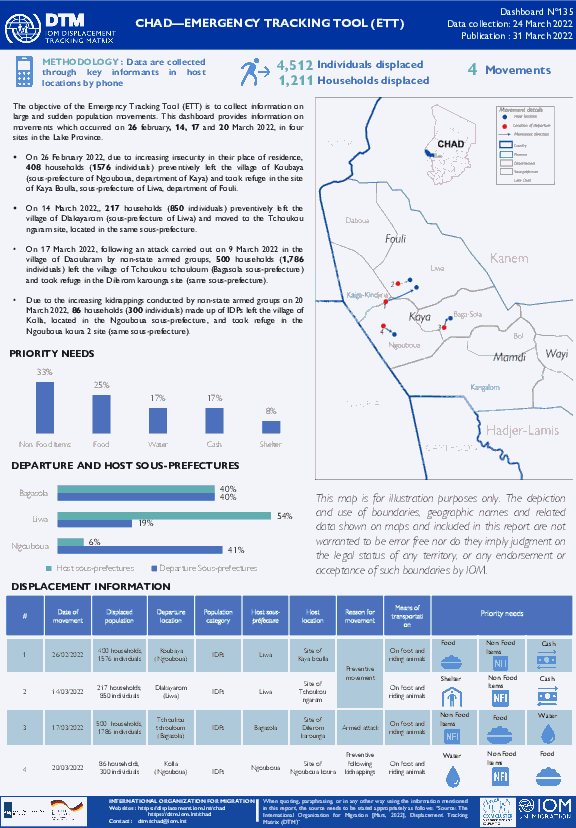
Contact
DTM Chad, dtmtchad@iom.int
Language
English
Location
Chad
Period Covered
Feb 26 2022
Mar 20 2022
Activity
- Event Tracking
- Mobility Tracking
The objective of the Emergency Tracking Tool (ETT) is to collect information on large and sudden population movements. This dashboard provides information on movements which occurred on 26 february, 14, 17 and 20 March 2022, in four sites in the Lake Province.
On 26 February 2022, due to increasing insecurity in their place of residence, 408 households (1576 individuals) preventively left the village of Koubaya (sous-prefecture of Ngouboua, department of Kaya) and took refuge in the site of Kaya Boulla, sous-prefecture of Liwa, department of Fouli.
On 14 March 2022, 217 households (850 individuals) preventively left the village of Dlakayarom (sous-prefecture of Liwa) and moved to the Tchoukou ngaram site, located in the same sous-prefecture.
On 17 March 2022, following an attack carried out on 9 March 2022 in the village of Daoularam by non-state armed groups, 500 households (1,786 individuals) left the village of Tchoukou tchouloum (Bagasola sous-prefecture) and took refuge in the Dilerom karounga site (same sous-prefecture).
Due to the increasing kidnappings conducted by non-state armed groups on 20 March 2022, 86 households (300 individuals) made up of IDPs left the village of Kolla, located in the Ngouboua sous-prefecture, and took refuge in the Ngouboua koura 2 site (same sous-prefecture).

Contact
DTM Tchad, dtmtchad@iom.int
Language
French
Location
Chad
Period Covered
Feb 26 2022
Mar 20 2022
Activity
- Event Tracking
- Mobility Tracking
Le suivi des urgences a pour but de recueillir des informations sur les mouvements importants et soudains de populations. Ce tableau de bord présente les informations sur les mouvements de personnes survenus le 26 février le 14, 17 et 20 mars 2022, dans quatre sites de la province du Lac.
Le 26 février 2022, en raison de l’insécurité croissante dans le lieu de provenance, 408 ménages (1576 individus) ont quitté d'une manière préventive le village de Koubaya (sous-préfecture de Ngouboua, département de Kaya) et se sont réfugiés dans le site de Kaya boulla (sous-préfecture de Liwa, département de Fouli).
Le 14 mars 2022, d’une manière préventive, 217 ménages (850 individus) ont quitté le village de Dlakayarom (sous-préfecture de Liwa) et se sont installés dans le site de Tchoukou ngaram, situé dans la même sous-préfecture.
Le 17 mars 2022, suite à une attaque survenue le 09 mars dans le village de Daoularam par des groupes armés non étatiques, 500 ménages (1786 individus) ont quitté le village de Tchoukou tchouloum (sous-préfecture de Bagasola) et se sont réfugiés dans le site de Dilerom karounga (même sous-préfecture).
En raison de la multiplication des enlèvements perpétrés par des groupes armés non étatiques en date du 20 mars 2022, 86 ménages (300 individus) constitués des PDI ont quitté le village de Kolla, localisé dans la sous-préfecture de Ngouboua pour se réfugier dans le site de Ngouboua koura 2 (même sous-préfecture).
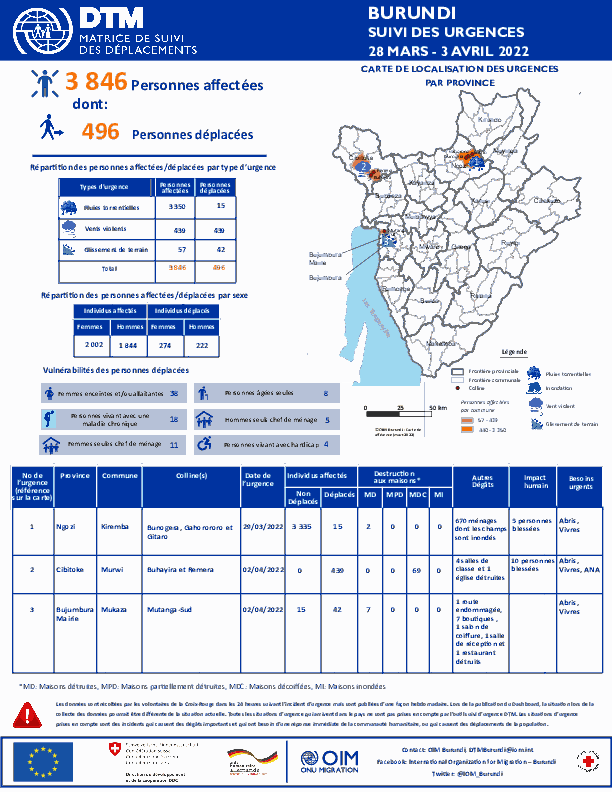
Contact
DTM Burundi, DTMBurundi@iom.int
Language
French
Location
Burundi
Period Covered
Mar 28 2022
Apr 03 2022
Activity
- Event Tracking
- Mobility Tracking
Entre le 28 Mars et le 3 Avril 2022, la DTM a identifié 3 846 personnes affectées, dont 496 personnes déplacées, par les pluies torrentielles, vents violents, Glissement de terrain et innondations dans les provinces de Ngozi, Bujumbura Mairie et Cibitoke.

Contact
DTM Tchad, dtmtchad@iom.int
Language
French
Location
Chad
Period Covered
Mar 19 2022
Mar 27 2022
Activity
- Event Tracking
- Mobility Tracking
Entre les 19 et 27 mars 2022, suite aux restrictions de mouvements dans le nord du Tchad édictées par les autorités locales, 252 migrants se sont retrouvés bloqués à 45 kilomètres au nord de la ville de Faya (Province du Borkou). Les données collectées à travers les enregistrements de ces 252 personnes, ont indiqué qu'elles sont de nationalités tchadienne (92%) et soudanaise (8%) et qu'elles venaient en majorité des provinces Wadi Fira (39%) et Ouaddaï (11%) au Tchad. Trente-six mineurs ont également été identifiés et enregistrés par L’Organisation internationale pour les migrations (OIM). l'OIM leur a distribué 252 kits contenant de la nourriture, des nattes et du charbon, mais il existe toujours un besoin urgent d'assistance en matière de nourriture, de soins de santé et de transport.
Selon les autorités locales, en plus de ces 252 migrants enregistrés, environ 148 autres ont été bloqués dans la même localité le 29 mars 2022 après les assistances et enregistrements conduits par l'OIM.
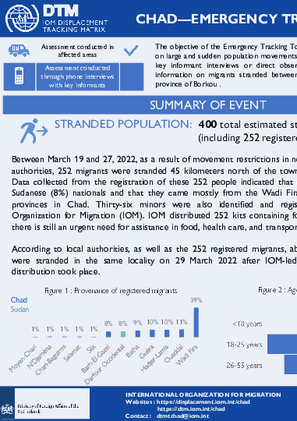
Contact
DTM Chad, dtmtchad@iom.int
Language
English
Location
Chad
Period Covered
Mar 19 2022
Apr 27 2022
Activity
- Event Tracking
- Mobility Tracking
Between March 19 and 27, 2022, as a result of movement restrictions in northern Chad issued by local authorities, 252 migrants were stranded 45 kilometers north of the town of Faya (Borkou Province). Data collected from the registration of these 252 people indicated that they are Chadian (92%) and Sudanese (8%) nationals and that they came mostly from the Wadi Fira (39%) and Ouaddaï (11%) provinces in Chad. Thirty-six minors were also identified and registered by the International Organization for Migration (IOM). IOM distributed 252 kits containing food, mats, and charcoal, but there is still an urgent need for assistance in food, health care, and transportation.
According to local authorities, as well as the 252 registered migrants, about 148 additional migrants were stranded in the same locality on 29 March 2022 after IOM-led registration and assistance distribution took place.